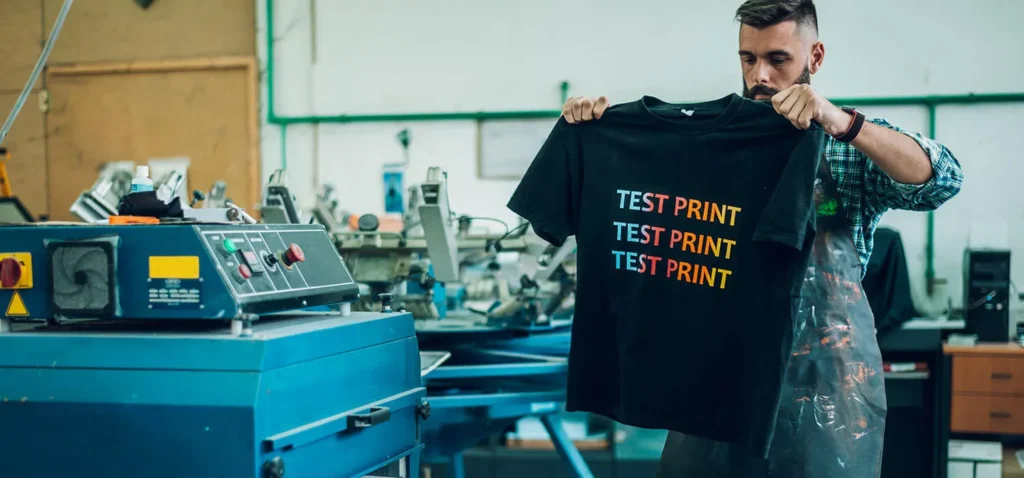Professional T-shirt printing has become a massive industry, allowing individuals, businesses, and organizations to create customized designs that reflect their unique brand or message.
From basic single-color prints to intricate multicolored patterns, the right printing technique can make all the difference in the quality and longevity of the design. With numerous printing methods available, each technique offers its own advantages depending on the type of fabric, design complexity, and desired finish.
This article will explore the most commonly used techniques in professional print t shirts and the benefits of each.
1. Screen Printing
Overview:
Screen printing, also known as silkscreen printing, is one of the oldest and most popular T-shirt printing techniques. It involves creating a stencil (or screen) for each color in the design, and ink is then pushed through the screen onto the fabric using a squeegee. This method works best for bulk orders and designs with solid colors.
Advantages:
- Durability: Long-lasting graphics that don’t fade after several washing are produced using screen printing.
- Vibrant Colors: The thick layers of ink used in screen printing result in bold and vibrant colors, making it ideal for simple, high-contrast designs.
- Cost-Effective for Large Quantities: While the initial setup can be time-consuming, it becomes cost-effective when printing large volumes.
Disadvantages:
- Limited Color Range: Screen printing works best for designs with fewer colors, as each color requires a separate screen, increasing the cost and complexity.
- Not Ideal for Complex Designs: Intricate patterns, gradients, or highly detailed artwork can be challenging to reproduce with this technique.
Best Used For:
Simple logos, text, and designs with up to four or five colors. Ideal for promotional merchandise, team uniforms, and company shirts.
2. Direct-to-Garment (DTG) Printing
Overview:
Direct-to-garment (DTG) printing uses specialized inkjet technology to print digital designs directly onto the fabric. This method offers greater flexibility in terms of color and design detail, as the printer can produce complex and multicolored designs easily.
Advantages:
- High-Detail Printing: DTG is perfect for intricate, multicolored designs and photographs, as it can capture fine details and color gradients.
- No Minimum Order: Unlike screen printing, DTG has minimal setup time, making it ideal for small orders or one-off custom prints.
- Soft Feel: The ink used in DTG printing is absorbed by the fabric, resulting in a soft and natural feel.
Disadvantages:
- Less Durable: DTG prints may not be as durable as screen-printed designs, and the colors may fade after multiple washes.
- Slower Production: Since each T-shirt is printed individually, DTG can be slower and more expensive for large-volume orders.
Best Used For:
Custom one-off T-shirts, small orders, or designs with complex artwork, full-color graphics, or photographs.
3. Heat Transfer Printing
Overview:
Heat transfer printing involves printing a design onto a special transfer paper and then using heat and pressure to transfer the ink from the paper onto the T-shirt. There are two main types of heat transfer methods: vinyl heat transfer and digital heat transfer.
- Vinyl Heat Transfer: This method involves cutting shapes or designs from colored vinyl sheets and then heat-pressing them onto the fabric.
- Digital Heat Transfer: This method uses a printer to transfer full-color images from a special paper to the fabric.
Advantages:
- Great for Customization: Heat transfer allows for highly customizable designs, including names, numbers, and detailed images.
- Versatile: It works well on a variety of fabrics and can be applied to different garments like T-shirts, hoodies, and hats.
- Sharp Detail: Heat transfer printing produces crisp, clear images with excellent color reproduction.
Disadvantages:
- Less Durable: Heat-transferred designs may crack or peel over time, especially after repeated washing.
- Not Ideal for Bulk Orders: This method can be time-consuming for large orders and may not be as cost-effective as screen printing.
Best Used For:
Personalized T-shirts, small batches, and designs with complex details, text, or logos that require customization.
4. Sublimation Printing
Overview:
Sublimation printing is a technique that uses heat to transfer dye onto fabric. The design is printed on a special transfer paper, and when heat is applied, the dye turns into gas and bonds with the fabric. Sublimation works best on polyester or polyester-blend fabrics and produces vibrant, full-color designs.
Advantages:
- Permanent Designs: Sublimation prints are embedded into the fabric itself, making them resistant to fading, cracking, or peeling.
- Full-Color and Complex Designs: This method allows for intricate, full-color designs with smooth gradients and photo-realistic results.
- Soft Finish: Since the dye becomes part of the fabric, the print is soft to the touch and breathable.
Disadvantages:
- Fabric Limitations: Sublimation works best on light-colored polyester fabrics. It is not suitable for cotton or dark-colored garments.
- Higher Cost for Small Orders: Sublimation printing can be expensive for small batches due to the specialized equipment and materials required.
Best Used For:
All-over prints, sportswear, and garments made from polyester or polyester blends.
5. Embroidery
Overview:
While not technically a printing technique, embroidery is another popular method for adding designs to T-shirts, particularly for logos and text. Embroidery uses thread to stitch designs onto fabric, creating a raised, textured look.
Advantages:
- Durability: Embroidered designs are highly durable and resistant to wear and tear.
- Professional Appearance: Embroidery adds a high-quality, professional touch to logos and text.
- Textured Finish: The raised texture gives a unique, tactile finish that stands out.
Disadvantages:
- Limited Design Options: Embroidery works best for simple designs with solid colors. It is not suitable for detailed or complex artwork.
- Higher Cost: Embroidery can be more expensive than other techniques, especially for larger, more intricate designs.
Best Used For:
Corporate logos, uniforms, and small text designs.
Choose the Right Technique for Professional T-shirt Printing
Choosing the right technique for professional T-shirt printing depends on your design, budget, and the purpose of the printed garments. Screen printing is ideal for bulk orders with simple designs, while DTG printing excels with intricate artwork and smaller batches. Heat transfer offers versatility, sublimation provides long-lasting, vibrant prints for polyester fabrics, and embroidery adds a textured, professional finish. By selecting the appropriate technique, you can ensure your T-shirts stand out and meet your specific needs.







